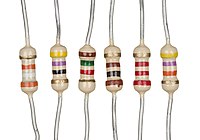
Photo from wikipedia
Abstract The purpose of this work was to investigate whether a modified anodizing process can successfully be applied to an ADC14 aluminum alloy casting to reduce its wear in a… Click to show full abstract
Abstract The purpose of this work was to investigate whether a modified anodizing process can successfully be applied to an ADC14 aluminum alloy casting to reduce its wear in a continuously-variable transmission component. The oxide film is formed by pulse anodizing after alloy heat treatment. The thickness and hardness of the oxide film were increased by adjusting the heat treatment temperature and by using an electrolyte composed of sulfuric acid, oxalic acid, and aluminum sulphate. The maximum thickness and hardness of the film were 18.3 μm and 442 HV, respectively. The film was produced by heat treating the casting at 350 °C, then pulse-anodizing it for 120 min. The wear loss of the oxide film was minimal under reciprocating, linear abrasion tests which lasted 5000 cycles. To validate the process in a practical application, the oxide film also exhibited good wear resistance when applied in a motorcycle engine that used a continuously-variable transmission. In addition, the engine horsepower was not compromised.
Journal Title: Wear
Year Published: 2020
Link to full text (if available)
Share on Social Media: Sign Up to like & get
recommendations!